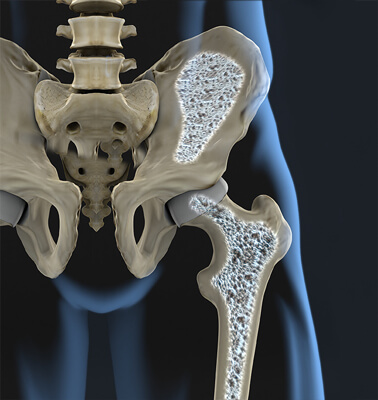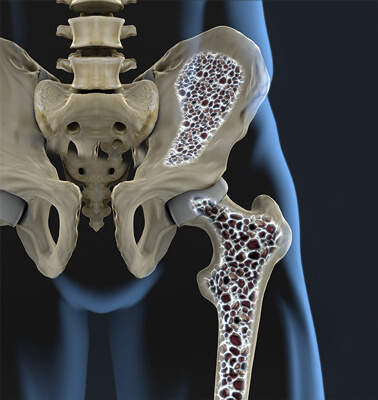skeletal strengthening for osteoporosis
WHAT IS OSTEOPOROSIS?
Osteoporosis is a silent disease that affects the integrity of your bone’s internal structure. The term osteoporosis means “porous bone.” When viewed under a microscope, healthy bone looks like a tightly formed honeycomb. When osteoporosis occurs, those holes and spaces have become much more extensive, indicating a loss of density that makes them both more fragile and susceptible to injury.
Most people don’t realize that bones are not solid rigid structures. Instead, each of our bones is part of a complex skeletal framework of living tissue undergoing a process of continual change called remodeling. We develop a strong skeletal system through the daily removal or resorption of bone mineral along with an equal deposit of new mineral. When this delicate balance of bone remodeling is disrupted, it can have an enormous impact on bone health and increase the risk of developing osteoporosis.
FACTORS ASSOCIATED WITH DEVELOPING OSTEOPOROSIS
According to the International Osteoporosis Foundation, some of the factors associated with developing osteoporosis include:
- Close family member diagnosed
- Family history of fractures and falls
- Frequent falls
- A previous fracture
- Long term bed rest
- Sedentary lifestyle
- Low body weight
- Loss in height
- Cessation of a woman’s period for more than 12 months
- Diet low in Vitamin D
- High alcohol intake
- Smoking
- Medications such as corticosteroids
- Age older than 60+
- Chronic disorders such as anorexia, Chron’s disease, liver disease, hyperthyroidism, post-transplantation, renal failure, Cushing’s syndrome, arthritis


Osteoporosis is disease that causes bones to become brittle and weak.Moving the slider to the right shows a healthy bone, compared to an osteoporotic bone when slid to the left..
WHO IS AT RISK?
After the age of about 30 years old, the average person naturally begins to lose bone density when bones lose the ability to rebuild at the same rate it breaks down. Women, in particular, face a higher risk of losing bone density as they age and enter menopause when hormone changes accelerate the loss of bone density.
ARE MEN AT RISK FOR OSTEOPOROSIS?
Yes. Men are absolutely at risk of being diagnosed with osteoporosis. It is vitally important for them to communicate with their doctors about their skeletal health. While it is true, men don’t experience hormone-related bone mass at the same rate as women experiencing menopause; bone loss accelerates as men age.
By around the age of 60, men begin to lose bone mass at the same rate as women. Once over 60, both men and women also experience a decrease in their ability to absorb calcium, an essential nutrient for bone health.
What are some of the risk factors for men?
According to the National Institutes for Health, there are several risk factors for men, including:
- Chronic diseases that affect the kidneys, lungs, stomach, and intestines or alter hormone levels
- Use of certain medications, such as glucocorticoids
- Low levels of the sex hormone testosterone
- Unhealthy lifestyle habits can accelerate the loss of bone density: smoking, excessive alcohol use, low calcium intake, and inadequate physical exercise
- Age. Your risk increases with advancing age
- Race. White men appear to be at particularly high risk, but all men can develop this disease
HOW DO YOU FIND OUT IF YOU HAVE OSTEOPOROSIS?
The most common test used to measure bone mass density, according to the International Osteoporosis Foundation , is a DXA scan or dual-energy X-ray absorptiometry. The test is painless and much like an x-ray, but without the same level of exposure to radiation. It can measure small incremental changes in bone density throughout your body but is most often used to measure BMD in the hip and spine.
Talk to Us now
Get a Free Session
© 2025 OsteoStrong® Lake Forest, All rights reserved. OsteoStrong® is licensed for use by OsteoStrong® Franchising, LLC.
*No physical exercise is 100% safe, and neither is OsteoStrong. OsteoStrong provides a unique way to emulate a high impact load of force to achieve osteogenic loading, without the high impact. While not 100% safe, OsteoStrong is significantly safer than attempting high impact force. OsteoStrong members have reported improved bone density, improved balance, improved strength, reduced joint pain, and reduced HbA1c. Results may vary. Consult your physician. Statements have not been evaluated by the FDA and are not intended to diagnose, treat, cure, or prevent any disease or health condition. OsteoStrong centers are independently owned and operated. OsteoStrong’s Science Advisor received his PhD from Rushmore University, certified/accredited in accordance with UK National Standards, but whose accreditation is not recognized in some jurisdictions. All rights reserved.

